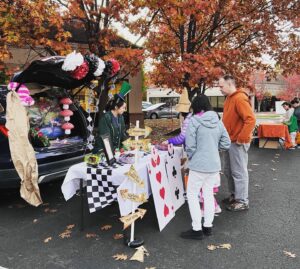 Brandon Sierchio, ME, BCBA
Brandon Sierchio, ME, BCBA
Southern NJ Regional Director
It’s October, which means Halloween is just around the corner! Many families are looking forward to the excitement of the holiday, from the cool costumes to sweet treats and more festivities to celebrate the occasion. This month provides children the opportunity to have fun and get into the spooky spirit.
But for families who have children with Autism Spectrum Disorder (ASD) or special needs, these festivities can become a source of stress and anxiety. With the right tips and tools, children can enjoy this special time of year. Below I’ve outlined some helpful ways for families to feel more at ease during the fall and Halloween season.
Before Halloween tips:
- Show pictures and videos of trick-or-treating.
- Preview your trick-or-treating route through the neighborhood.
- Dress them in their costume before the big day! Make sure they’re comfortable in it, so you can make alterations to it before the holiday.
- If your child doesn’t like their costume, don’t make them wear it. Instead, try to uncover why they don’t like it.
- Consider a costume that fits over your child’s regular clothes, such as butterfly wings or capes.
- Take them through a full-dress rehearsal – maybe some neighbors would even be willing to participate!
Halloween day tips:
- Know your child’s limits and only do what he or she can handle.
- Partner up with family and friends that your child likes and who they’re comfortable around.
- Give your child the option to hand out candy at your home. You can practice handing out the candy earlier in the day before trick-or-treaters arrive.
- If your child is afraid of going out at night, plan indoor or daytime Halloween activities.

Traditional trick-or-treating can be challenging for children with ASD and special needs because they may have a difficult time verbalizing and communicating their wants or needs.
“When it comes to the communication piece of trick-or-treating I think it’s really important for parents of children with ASD and all individuals giving out candy to understand how something so “easy” can be very difficult, overstimulating, and overwhelming,” says Stephanie Gardner, MS, BCBA, Assistant Director in First Children’s Southern NJ STRIVE center.
“Having picture icons while trick or treating (even for verbal children) may ease some of that anxiety while trick or treating. Having the icon card on their bucket or pinned to their costume for easy access may help. I also think that parents can say “trick or treat” and “thank you” for their children and it’s 100% acceptable! Not everyone can communicate as the majority does. We need to make the majority see that that’s ok.”
At our autism STRIVE center in Mount Laurel, staff practice trick-or-treating with the children to help them rehearse their social cues, such as knocking on doors, saying “trick or treat” and creating appropriate responses.

“Us practicing in the center, allows the children to have a small taste of the experience in a controlled environment with familiar support,” explains Gardner. “I think the biggest takeaway for parents on Halloween is to let their kids have fun and this exercise can help with that process!”
Trunk-or-treat events have become a popular alternative to trick-or-treating because they’re also in a more controlled environment. At a trunk or treat event children do not need to walk long distances, it’s safer than walking on a crowded street and it’s more convenient. They also lend to a more engaging environment, as well.
We hope these tips help your family feel more at ease this Halloween. Remember above all else, no matter how the night goes, find your child’s strength and reinforce it. It doesn’t need to be perfect as long as your child enjoys themselves because that’s what matters!
